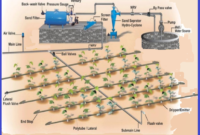Drip irrigation was used to the ancient custom in certain parts of India of irrigating a tulsi plant kept in the courtyard. During the summer months, the plant was irrigated by a hanging pitcher containing water and a minute hole at its bottom to allow the trickling of water on to the plant. The tribal farmers of Arunachal Pradesh practised a primitive form of drip irrigation system using a slender bamboo as the conduit for water flow.
The use of drippers in sub-surface irrigation network was first experimented in Germany in 1869. The noticeable growth of the petrochemical industry during and after the 1950s aided manufacturing of plastic pipes at a cost much cheaper than the cost of metallic or cement concrete pipes.
Plastic pipes are convenient for water conveyance under pressure and the plastic material are easily formed into the desired configuration. These features of plastic made the field-scale use of drip irrigation practicable. The drip system was developed for field crops in Israel in the early 1960s and in Australia and North America in the late 1960s.
Drip Irrigation Layout and Its Parts:

